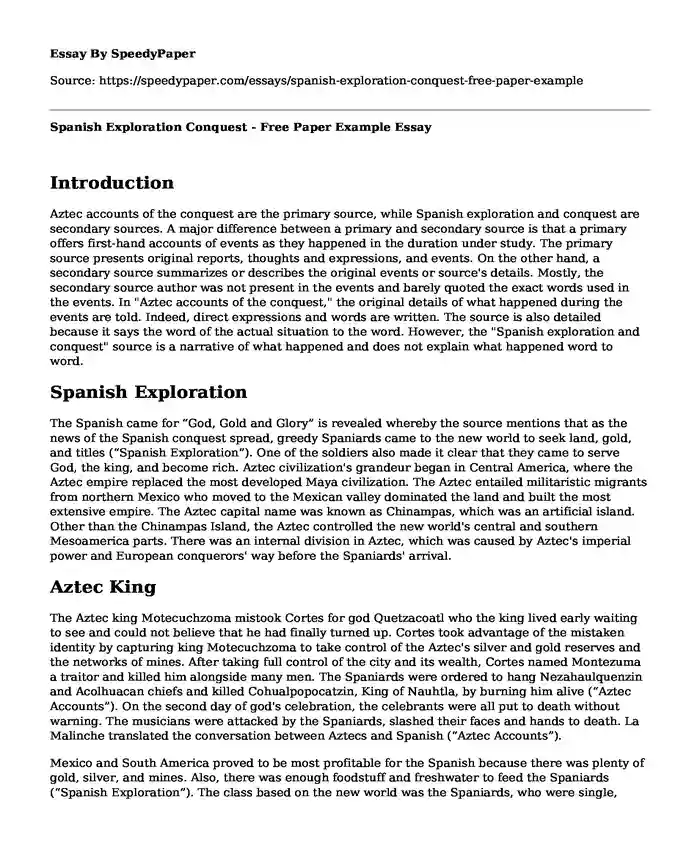Introduction
Aztec accounts of the conquest are the primary source, while Spanish exploration and conquest are secondary sources. A major difference between a primary and secondary source is that a primary offers first-hand accounts of events as they happened in the duration under study. The primary source presents original reports, thoughts and expressions, and events. On the other hand, a secondary source summarizes or describes the original events or source's details. Mostly, the secondary source author was not present in the events and barely quoted the exact words used in the events. In "Aztec accounts of the conquest," the original details of what happened during the events are told. Indeed, direct expressions and words are written. The source is also detailed because it says the word of the actual situation to the word. However, the "Spanish exploration and conquest" source is a narrative of what happened and does not explain what happened word to word.
Spanish Exploration
The Spanish came for “God, Gold and Glory” is revealed whereby the source mentions that as the news of the Spanish conquest spread, greedy Spaniards came to the new world to seek land, gold, and titles (“Spanish Exploration”). One of the soldiers also made it clear that they came to serve God, the king, and become rich. Aztec civilization's grandeur began in Central America, where the Aztec empire replaced the most developed Maya civilization. The Aztec entailed militaristic migrants from northern Mexico who moved to the Mexican valley dominated the land and built the most extensive empire. The Aztec capital name was known as Chinampas, which was an artificial island. Other than the Chinampas Island, the Aztec controlled the new world's central and southern Mesoamerica parts. There was an internal division in Aztec, which was caused by Aztec's imperial power and European conquerors' way before the Spaniards' arrival.
Aztec King
The Aztec king Motecuchzoma mistook Cortes for god Quetzacoatl who the king lived early waiting to see and could not believe that he had finally turned up. Cortes took advantage of the mistaken identity by capturing king Motecuchzoma to take control of the Aztec's silver and gold reserves and the networks of mines. After taking full control of the city and its wealth, Cortes named Montezuma a traitor and killed him alongside many men. The Spaniards were ordered to hang Nezahaulquenzin and Acolhuacan chiefs and killed Cohualpopocatzin, King of Nauhtla, by burning him alive (“Aztec Accounts”). On the second day of god's celebration, the celebrants were all put to death without warning. The musicians were attacked by the Spaniards, slashed their faces and hands to death. La Malinche translated the conversation between Aztecs and Spanish (“Aztec Accounts”).
Mexico and South America proved to be most profitable for the Spanish because there was plenty of gold, silver, and mines. Also, there was enough foodstuff and freshwater to feed the Spaniards (“Spanish Exploration”). The class based on the new world was the Spaniards, who were single, young, male, and emigrated people searching for wealth, then there were craftsmen, laborers, clerks, soldiers, priests, and the Indians. The highest class was Spaniards with pure Spanish blood. Anyone with the Spanish blood was most privileged. Spanish men married Indian women because there were few Spanish women, and their union was called Mestizos. Guadalupe's lady acted as a national icon for mestizo society, which entailed both Indians and Spanish (“Spanish Exploration”). The presence of Lady of Guadalupe shows that God was on the side of the Mestizos.
Conclusion
In the 21st century, the Spanish still believe in the protection of the lady of Guadalupe. Also, much force is applied by the drug lords to gain wealth, just like in history. The Spanish-Indians are still considered inferior compared to pure Spanish. In America, a person's ethnicity is still considered essential for them to thrive in society and gain social status. For instance, the whites are considered the most superior, while the Spanish and the Indians are the minors.
Works Cited
Aztec accounts of the conquest | US history I (AY collection). (n.d.). Lumen Learning – Simple Book Production. https://courses.lumenlearning.com/suny-ushistory1ay/chapter/primary-source-reading-aztec-accounts-of-the-conquest/
Spanish exploration and conquest | US history I (AY collection). (n.d.). Lumen Learning – Simple Book Production. https://courses.lumenlearning.com/suny-ushistory1ay/chapter/spanish-exploration-and-conquest/.
Cite this page
Spanish Exploration Conquest - Free Paper Example. (2023, Nov 24). Retrieved from https://speedypaper.net/essays/spanish-exploration-conquest-free-paper-example
Request Removal
If you are the original author of this essay and no longer wish to have it published on the SpeedyPaper website, please click below to request its removal:
- Free Essay on Gender Roles in an American Culture
- Nonprofit Organizations Essay Example
- Free Essay in History: The Treaty of Versailles
- Paper Sample on Board Diversity Analysis in Stitch Fix Inc
- The Crisis Deepens: World War II, Free Essay Sample
- Paper Example on the Cold War Between the United States and the Soviet Union
- Free Essay Example - Asian Culture on an Oral Health Basis
Popular categories





